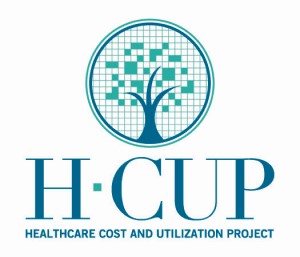SDOH Data and Analytics
AHRQ Datasets
AHRQ has extensive data resources that can be used today by researchers to study the relationships between health, SDOH, and healthcare.
Social Determinants of Health Database
These files contain version 1 of AHRQ’s database on Social Determinants of Health (SDOH), which was created under a project funded by the Patient Centered Outcomes Research (PCOR) Trust Fund. The database is curated from existing Federal datasets and other publicly available data sources. The purpose of these files is to make it easier to find a range of well-documented, readily linkable SDOH variables across domains without having to access multiple source files, facilitating SDOH research and analysis.
Variables in the files correspond to five key SDOH domains: social context, economic context, education, physical infrastructure, and healthcare context. The files can be linked to other data by geography. Data are available at the county, ZIP Code, and census tract levels.
 The Healthcare Cost and Utilization Project (HCUP)
The Healthcare Cost and Utilization Project (HCUP)
The Healthcare Cost and Utilization Project (HCUP) includes the largest collection of longitudinal hospital care data in the United States, with all-payer, encounter-level information beginning in 1988. HCUPNet, a free, online query tool, provides access to health statistics and information on hospital inpatient and emergency department utilization. National and State-level datasets, available for purchase, include inpatient, pediatric, and emergency department discharge data, as well as ambulatory surgery and readmission databases.
SDOH variables that can be studied in HCUP databases include: race, ethnicity, median household income for patient's ZIP Code, population density (i.e., urban-rural continuum), homelessness (for some States), and expected payer. In addition, the HCUP data can be used in conjunction with other data sources using geographic indicators, including county and ZIP Code of patient or of hospital where care was received, depending on the HCUP dataset.
Find information on HCUP, HCUP online query tools and obtaining HCUP data.
 The Medical Expenditure Panel Survey (MEPS)
The Medical Expenditure Panel Survey (MEPS)
The Medical Expenditure Panel Survey (MEPS), which began in 1996, is a set of large-scale surveys of families and individuals, their medical providers (doctors, hospitals, pharmacies, etc.), and employers across the United States. MEPS collects data on the specific health services that Americans use, how frequently they use them, the cost of these services, and how they are paid for, as well as data on the cost, scope, and breadth of health insurance held by and available to U.S. workers.
Individual-level SDOH variables that can be studied in the MEPS household survey datasets include:
- Demographics (e.g., age, sex, race, ethnicity, nativity/time in the U.S., language).
- Socioeconomics (household income, education, employment, food insecurity).
- Attitudes and values (risk tolerance, attitudes about insurance and doctors, past experiences with health care providers).
- Community (e.g., urban-rural location of residence, point of care).
- Access to care (e.g., public and private insurance coverage and eligibility, usual source of care, unmet need).
Download MEPS public use microdata files.
In addition, all sample households are geocoded and can be linked to a variety of geographic and/or spatial data (e.g., county or tract characteristics, spatial environmental data, distance to providers or facilities). To do so, analysts must apply for permission to use these data in the AHRQ Secure Data Center or an affiliated Census Research Data Center.
To enhance the ability to study SDOH, AHRQ is fielding a self-administered questionnaire (SAQ) that will ask adult respondents additional questions related to food insecurity, housing security, transportation, financial strain, general well-being, social connectedness, physical safety, and adverse childhood experiences.
Selected Finding from these datasets
AHRQ publishes Statistical Briefs using data from HCUP and MEPS. Below are some Stat Briefs published in recent years that relate to SDOH.
- Obstetric Delivery Inpatient Stays Involving Substance Use Disorders and Related Clinical Outcomes, 2016
- Overview of U.S. Hospital Stays in 2016: Variation by Geographic Region
- Trends and Disparities in Delivery Hospitalizations Involving Severe Maternal Morbidity, 2006-2015; Infographic (PDF).
- Characteristics of Homeless Individuals Using Emergency Department Services in 2014
- Using Geographic Information to Target Health Disparities: State Experience. This 2016 brief describes how two States have analyzed race and ethnicity data and targeted interventions to specific geographic locations.
- Insurance and Access to Care in Urban and Rural Areas, 2014-2015.
- Children's Usual Source of Care: Insurance, Income, and Racial/Ethnic Disparities, 2004-2014
AHRQ collects data on SDOH and produces reports, chartbooks, and brief data analyses.
National Healthcare Quality and Disparities Reports (QDR)
The National Healthcare Quality and Disparities Report (QDR) presents trends for measures related to access to care, affordable care, care coordination, effective treatment, healthy living, patient safety, and person-centered care using national data. The report presents, in chart form, the latest available findings on quality of and access to healthcare, as well as disparities related to race and ethnicity, income, and other SDOH.
NHQDR Chartbooks related to SDOH include:
- Rural Health Care (updated October 2017) (PDF, 2.5 MB).
- Care Affordability (updated August 2016) (PDF, 1.53 MB).
- Access (updated May 2016) (PDF, 3 MB).
- Health Care for Blacks (February 2016) (PDF, 2.96 MB).
- Hispanic Health Care (September 2015) (PDF, 4.4 MB).
You can conduct your own SDOH analyses of QDR data using the free online query tool. The available disparity categories are race, ethnicity, education, income, geographic location, gender, and health insurance status. Disparities data may be limited for some measures.
You can also view the data by State using the State Snapshots tool. The available disparity categories in the State Snapshots tool are race, ethnicity, and income.
Datasets and Analytic Tools That Can Power SDOH Research
You can conduct your own SDOH analyses using AHRQ’s free online query tools.
- HCUPnet. The available SDOH categories are community-level income, urbanicity/rurality, expected payer, and community-level statistics. In addition, you can get quick statistics on HCUP Fast Stats to examine topics by community-level income, urbanicity/rurality, and expected payer.
- MEPS Data Tools. The available SDOH categories available on the MEPS Data Tools are age, sex, race, ethnicity, marital status, employment status, income, insurance coverage, self-rated health and mental health, and geographic region of residence.
AHRQ Visualization Resources of Community-Level Social Determinants of Health Challenge
The AHRQ Visualization Resources of Community-Level Social Determinants of Health Challenge seeks tools that support visualizing data clusters to enhance the research and analysis of community-level health services. Challenge participants were charged with developing visualization tools to augment the insights drawn from the analysis of medical expenditure and healthcare utilization data at the community level. Tools must use publicly available and free SDOH data from Federal, State, or locally available data sources. In February, AHRQ awarded Mathematica the grand prize of the Agency’s Visualization Resources of Community Health-Level Social Determinants of Health Challenge for its “Community Connector” data visualization tool. The grand prize comes with a $50,000 award. Salish Research Group was named the runner up and will receive $35,000, and Rensselaer Polytechnic Institute was named third-place finisher and will receive $15,000. For more details, read the AHRQ Views blog and press release.



